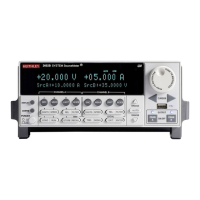Series 2600 System SourceMeters Reference Manual Speed Specification Test Conditions E-3
Return to Appendix E topics 2600S-901-01 Rev. A / May 2006
3. Unit is placed in sync with the test program to guarantee that the timing
results will not include execution time from previous commands. A simple
way to sync the unit is to issue a print command.
Private Sub Sync_Unit()
ReceiveBuffer = ""
TransmitBuffer = "print('done')" & CRLF
VisaStatus = viWrite(VisaSession, TransmitBuffer, Len(TransmitBuffer), ReturnCount)
VisaStatus = viRead(VisaSession, ReceiveBuffer, MAX_BUFFER, ReturnCount)
End Sub
4. A snapshot of the timer is taken, after which the script mentioned in step 2
is sent to the unit. The test program collects all data returned from the
instrument. In the case of “X to memory” tests, a single result is sent to the
test program notifying that the test is done. In the case of “X to gpib” speed
tests, the program receives all measured data. Finally, another snapshot of
the timer is taken. The difference between the start and end time is the
speed result.
Single Measurement Rates
The procedure for a Single Measurement Rate test is listed below:
1. A script puts the Series 2600 into a known test state maximizing
performance of the instrument. It sets up the unit to return one
measurement at a time.
2. The unit is placed in sync with the test program to guarantee that the timing
will not include an execution time from a previous command.
3. A snapshot of the timer is taken after which the script is sent to the unit. A
loop in the test program sends a series of measure commands and obtains
results one at a time. When the loop is completed, another snapshot of the
timer is taken. The difference between the start and end time is the speed
result.
Function and Range Change Rates
The procedure for a Function and Range Change Rate test is listed below:
1. A script puts the Series 2600 into a known test state, maximizing
performance of the instrument. It is sent to the instrument but not executed.
It configures the unit to take a large number of samples that either make
range or function changes.
2. The unit is placed in sync with the test program to guarantee that the timing
will not include an execution time from previous commands.
3. A snapshot of the timer is taken after which the script is sent to the unit. The
test program gets a signal from the unit notifying that the test is complete.
Another snapshot of the timer is taken. The difference between the start
and end time is the speed result.

